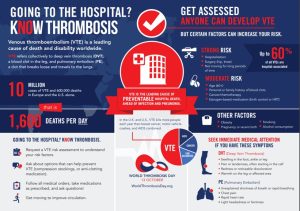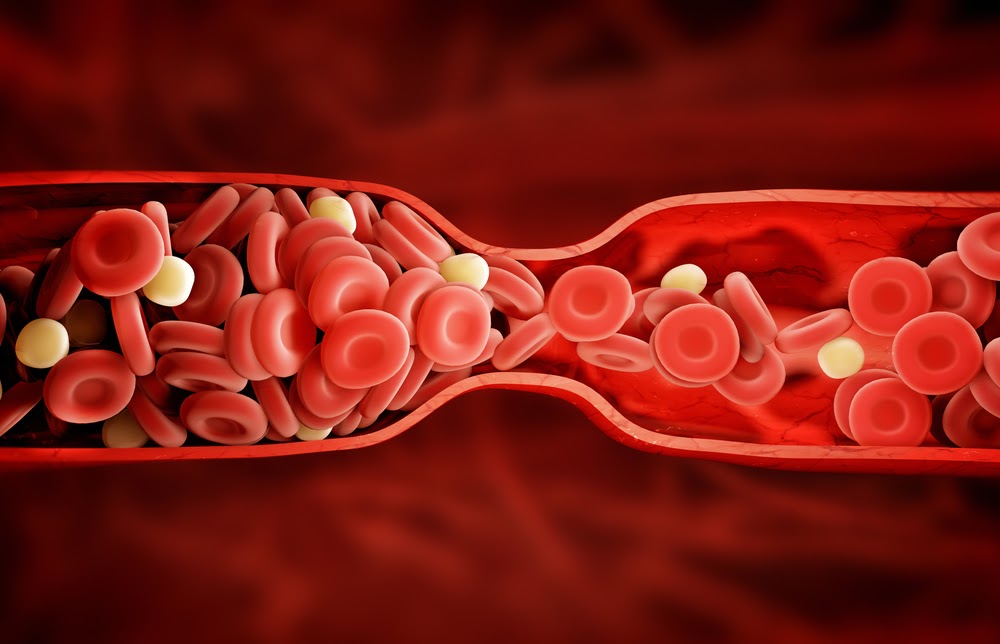Blood Clots are the Leading Cause of Death in Hospitalized Patients; Be an Advocate & Request a VTE Risk Assessment
Being in the hospital is a major risk factor for the development of a life-threatening blood clot called venous thromboembolism (VTE).
Anyone with decreased mobility due to bedrest or recovery, who experienced blood vessel trauma due to surgery or other serious injury are more likely to develop blood clots. This also applies to patients facing long hospital stays due to cancer, pregnancy, and others.
Patients who may have put off elective procedures during the pandemic may now be rescheduling these procedures, leading to new hospital stays.
KEY TERMS
Thrombosis – the formation of a blood clot in a blood vessel. The vessel may be any vein or artery as for example, in a deep vein thrombosis (venous) or a coronary artery (arterial). Watch a short video from the World Thrombosis Day campaign to learn more about how a blood clot forms.
Deep Vein Thrombosis (DVT) – a condition where a blood clot forms in the deep veins of the leg.
Pulmonary Embolism (PE) – when a blood clot travels in the circulation and lodges in the lungs.
Venous Thromboembolism (VTE) – one of the top three cardiovascular killers, caused by the combination of DVT and PE.
THE CONNECTION BETWEEN HOSPITAL STAYS AND THROMBOSIS
“Blood clots are one of the most often overlooked conditions formed due to being unwell in hospital. Luckily we can risk assess people admitted to hospital and if they are at risk, reduce the risk with small doses of blood thinners. Often the clots occur after discharge so being aware of the signs, symptoms of deep vein thromboses and pulmonary emboli can be the difference between life and death. This knowledge is as important for the patient to have as it is for the medical professional.”
– Prof. Beverley Hunt, O.B.E., World Thrombosis Day Steering Committee Chair, Professor of Thrombosis and Haemostasis at King’s College, and Co-Founder and Medical Director of Thrombosis UK.
HOW HOSPITALIZED PATIENTS CAN BE PROACTIVE
*World Thrombosis Day experts recommend that all hospitalized patients facing prolonged immobility or
with outstanding risk factors be proactive by asking their doctors for a VTE Risk Assessment which is a simple questionnaire gathering information about a patient’s age,
medical history, medications and specific lifestyle factors.
This assessment may lead to additional testing or procedures including the following:
D–Dimer blood test – monitors for a protein fragment from the breakdown of a blood clot.
Ultrasound – scan of the arm or leg to look for DVT.
CAT scan – scan of the chest with intravenous dye to look for a PE.
Also, patients should ask whether they are a candidate for preventive methods referred to as prophylaxis, which can include the following:
Anti-clotting medications (e.g., anticoagulants)
Mechanical devices (e.g., intermittent pneumatic compression devices or rapid inflation venous foot pumps, graded compression stockings or compression stockings)

ADDITIONAL INFORMATION ON HOSPITAL-ASSOCIATED VTE
BACKGROUND
Up to 60 percent of all VTE cases occur during or within 90 days of hospitalization, making it a leading cause of hospital death.
To prevent VTE, hospital staff should evaluate patients for their risk of developing blood clots and use proper prevention and treatment procedures.
FACTS & FIGURES
In the UK, upwards of 32,000 cases of hospital-associated VTE occur every year
In the U.S., more than 550,000 hospitalized patients develop VTE every year
In Australia, 30,000 cases of hospital-associated VTE occur every year
PROCEDURES ASSOCIATED WITH INCREASED VTE RISK
- Orthopedic Surgery (e.g., total hip or knee surgery)
- Major general surgery (especially involving the abdomen, pelvis, hip or legs)
- Major gynecological surgery
- Urological surgery
- Cardiothoracic surgery
- Neurosurgery
- Major peripheral vascular surgery
- Chemotherapy for cancer treatment

